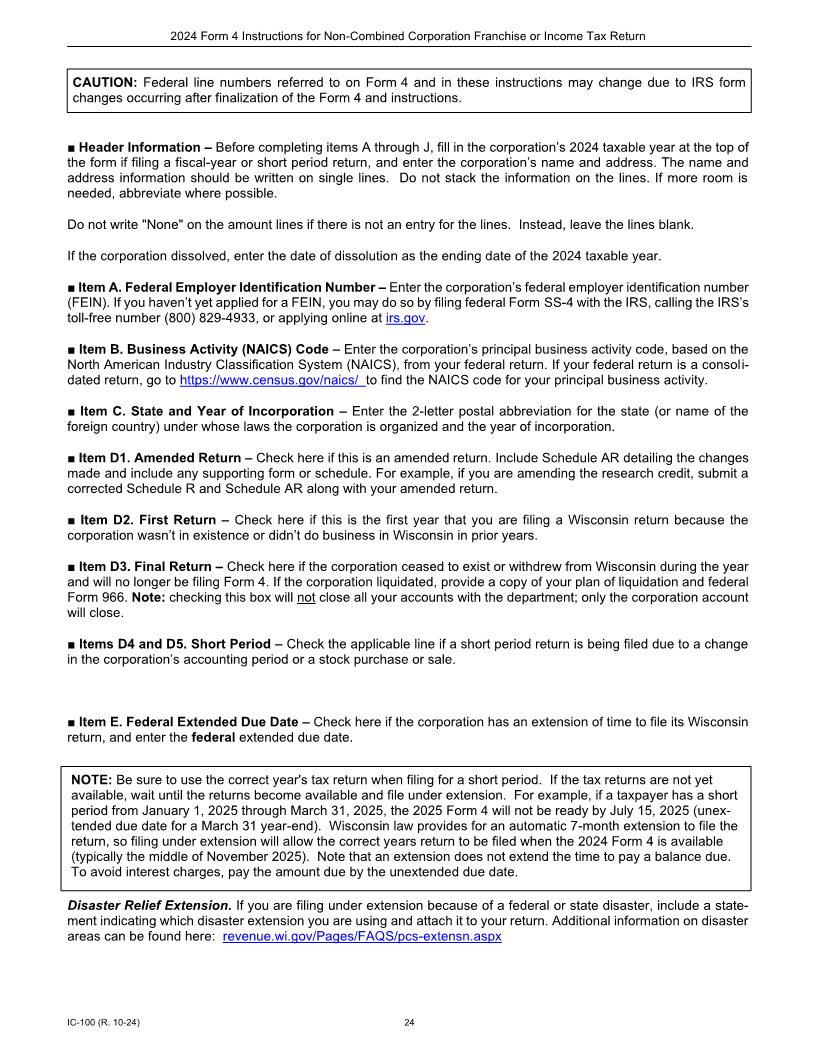
Enlarge image
2024 Form 4 Instructions for Non-Combined Franchise Income Tax Return
Table of Contents
Who Must File Form 4 ............................................................................................................................................. 2
Corporations Required to File ................................................................................................................................................ 2
“Doing Business in Wisconsin” .............................................................................................................................................. 3
Franchise or Income Tax ....................................................................................................................................................... 4
Economic Development Surcharge ....................................................................................................................................... 5
Separate Return or Combined Return? ................................................................................................................ 5
Combined Returns and Groups in General ............................................................................................................................ 5
Test 1: Commonly Controlled Group...................................................................................................................................... 5
Test 2: Unitary Business ........................................................................................................................................................ 6
Test 3: Water’s Edge ............................................................................................................................................................. 8
General Franchise or Income Tax Return Instructions ....................................................................................... 9
When and Where to File ........................................................................................................................................................ 9
Period Covered by Return ................................................................................................................................................... 10
Accounting Methods and Elections ...................................................................................................................................... 10
Payment of Estimated Tax ................................................................................................................................................... 10
Required Disclosures and Attachments ............................................................................................................................... 11
Internal Revenue Service Adjustments, Amended Returns, and Claims for Refund ............................................................ 12
Final Return ......................................................................................................................................................................... 13
Penalties for Not Filing or Filing Incorrect Returns ............................................................................................................... 13
Conformity with Internal Revenue Code and
Exceptions ............................................................................................................................................................. 13
Provisions of the Internal Revenue Code Not Adopted by Wisconsin: ................................................................................. 14
Capital Losses ..................................................................................................................................................................... 19
Limitations on Certain Federal Deductions .......................................................................................................................... 19
Differences Between Federal and Wisconsin Basis of Assets ............................................................................................. 19
General Instructions for Apportionment ............................................................................................................ 19
Who Must Use Apportionment ............................................................................................................................................. 20
Apportionment Method......................................................................................................................................................... 20
Nonapportionable Income .................................................................................................................................................... 21
Separately Apportioned Income ........................................................................................................................................... 21
Corporate Partners or LLC Members ................................................................................................................................... 21
Separate Accounting............................................................................................................................................................ 21
Treatment of Specialized Industries and Entities .............................................................................................. 22
Foreign Sales Corporations (FSCs) ..................................................................................................................................... 22
Interest Charge Domestic International Sales Corporations (IC-DISCs) .............................................................................. 22
Insurance Companies .......................................................................................................................................................... 22
Personal Holding Companies .............................................................................................................................................. 22
RICs, REMICs, REITs, and FASITs ..................................................................................................................................... 23
Tax Exempt Organizations ................................................................................................................................................... 23
Urban Transit Companies .................................................................................................................................................... 23
Line-by-Line Instructions for Form 4 .................................................................................................................. 23
Additional Information, Assistance, and Forms ................................................................................................ 32
Web Resources .................................................................................................................................................................. 32
Obtaining Forms ................................................................................................................................................................ 32
IC-100 (R. 10-24) 1































